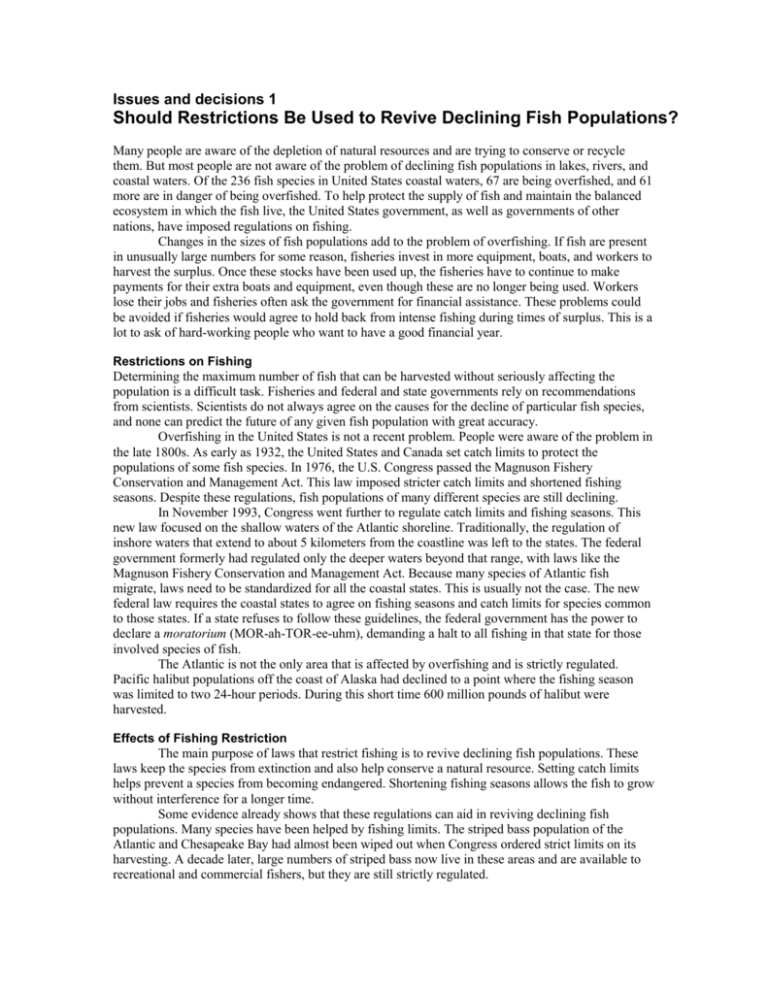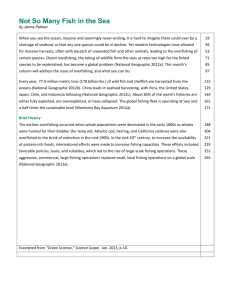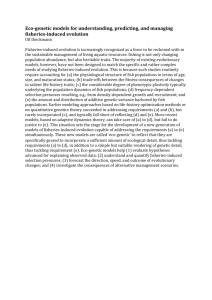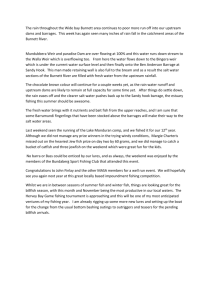Issues and decisions 9 - Liberty Union High School District
advertisement

Issues and decisions 1 Should Restrictions Be Used to Revive Declining Fish Populations? Many people are aware of the depletion of natural resources and are trying to conserve or recycle them. But most people are not aware of the problem of declining fish populations in lakes, rivers, and coastal waters. Of the 236 fish species in United States coastal waters, 67 are being overfished, and 61 more are in danger of being overfished. To help protect the supply of fish and maintain the balanced ecosystem in which the fish live, the United States government, as well as governments of other nations, have imposed regulations on fishing. Changes in the sizes of fish populations add to the problem of overfishing. If fish are present in unusually large numbers for some reason, fisheries invest in more equipment, boats, and workers to harvest the surplus. Once these stocks have been used up, the fisheries have to continue to make payments for their extra boats and equipment, even though these are no longer being used. Workers lose their jobs and fisheries often ask the government for financial assistance. These problems could be avoided if fisheries would agree to hold back from intense fishing during times of surplus. This is a lot to ask of hard-working people who want to have a good financial year. Restrictions on Fishing Determining the maximum number of fish that can be harvested without seriously affecting the population is a difficult task. Fisheries and federal and state governments rely on recommendations from scientists. Scientists do not always agree on the causes for the decline of particular fish species, and none can predict the future of any given fish population with great accuracy. Overfishing in the United States is not a recent problem. People were aware of the problem in the late 1800s. As early as 1932, the United States and Canada set catch limits to protect the populations of some fish species. In 1976, the U.S. Congress passed the Magnuson Fishery Conservation and Management Act. This law imposed stricter catch limits and shortened fishing seasons. Despite these regulations, fish populations of many different species are still declining. In November 1993, Congress went further to regulate catch limits and fishing seasons. This new law focused on the shallow waters of the Atlantic shoreline. Traditionally, the regulation of inshore waters that extend to about 5 kilometers from the coastline was left to the states. The federal government formerly had regulated only the deeper waters beyond that range, with laws like the Magnuson Fishery Conservation and Management Act. Because many species of Atlantic fish migrate, laws need to be standardized for all the coastal states. This is usually not the case. The new federal law requires the coastal states to agree on fishing seasons and catch limits for species common to those states. If a state refuses to follow these guidelines, the federal government has the power to declare a moratorium (MOR-ah-TOR-ee-uhm), demanding a halt to all fishing in that state for those involved species of fish. The Atlantic is not the only area that is affected by overfishing and is strictly regulated. Pacific halibut populations off the coast of Alaska had declined to a point where the fishing season was limited to two 24-hour periods. During this short time 600 million pounds of halibut were harvested. Effects of Fishing Restriction The main purpose of laws that restrict fishing is to revive declining fish populations. These laws keep the species from extinction and also help conserve a natural resource. Setting catch limits helps prevent a species from becoming endangered. Shortening fishing seasons allows the fish to grow without interference for a longer time. Some evidence already shows that these regulations can aid in reviving declining fish populations. Many species have been helped by fishing limits. The striped bass population of the Atlantic and Chesapeake Bay had almost been wiped out when Congress ordered strict limits on its harvesting. A decade later, large numbers of striped bass now live in these areas and are available to recreational and commercial fishers, but they are still strictly regulated. Other marine animals also benefit from government regulation. The banning of driftnets protects whales and dolphins. Special nets used in the harvesting of shrimp have “turtle excluders,” or escape hatches, so that sea turtles and fish can swim out of the nets. These regulations also aim at preserving entire ecosystems, not just a few species of organisms in the ecosystem. Opposition to Fishing Restrictions The major opposition to strict fishing regulations comes from the fishing industry. Some opponents doubt that making laws will solve the problem of declining fish populations, because more factors than overfishing are involved in the problem. Many commercial fishers invest large amounts of money in the boats and equipment used to harvest fish. If the fish season is greatly reduced, they must lay off workers. A controversial ban on cod fishing in Canada caused 20,000 Newfoundland workers to lose their jobs. If a large percentage of a town’s population is involved in the fishing industry, the resulting unemployment is likely to hurt the town’s economy. When fishing seasons are reduced to very short spans of time, as in the case of the Pacific halibut, other problems arise. These short seasons force laborers to work around the clock at an extremely fast pace. Under these exhausting conditions, work-related accidents and injuries are more likely to occur. Overfishing alone is not entirely responsible for the declining populations of fish in fresh waters and in oceans. The building of dams can kill fish or prevent them from breeding. The loss of a species’ habitat due to human activities affects populations of fish. These problems also need to be addressed. Consumers could broaden their tastes to include fish species with plentiful stocks, such as mackerel and pollock. There might then be less demand for fish with less plentiful stocks. Review 1. How do natural changes in fish populations affect overfishing? 2. How do laws that regulate fishing protect fish populations? 3. How does the 1993 federal law on fishing regulation differ from previous laws? 4. What are the drawbacks to legislation limiting fish catches and establishing shorter fishing seasons? 5. List four reasons why fish populations are declining in lakes, rivers, and oceans. Decisions 1. Suppose you are a politician representing the interests of a small community whose economic health depends on the fishing industry. How would you approach the problem of the overfishing of nearby species? 2. Do you think federal laws regulating the fishing industry are necessary? Why or why not?








